BUICK LACROSSE 2007 Owner's Manual
Manufacturer: BUICK, Model Year: 2007, Model line: LACROSSE, Model: BUICK LACROSSE 2007Pages: 512
Page 201 of 512
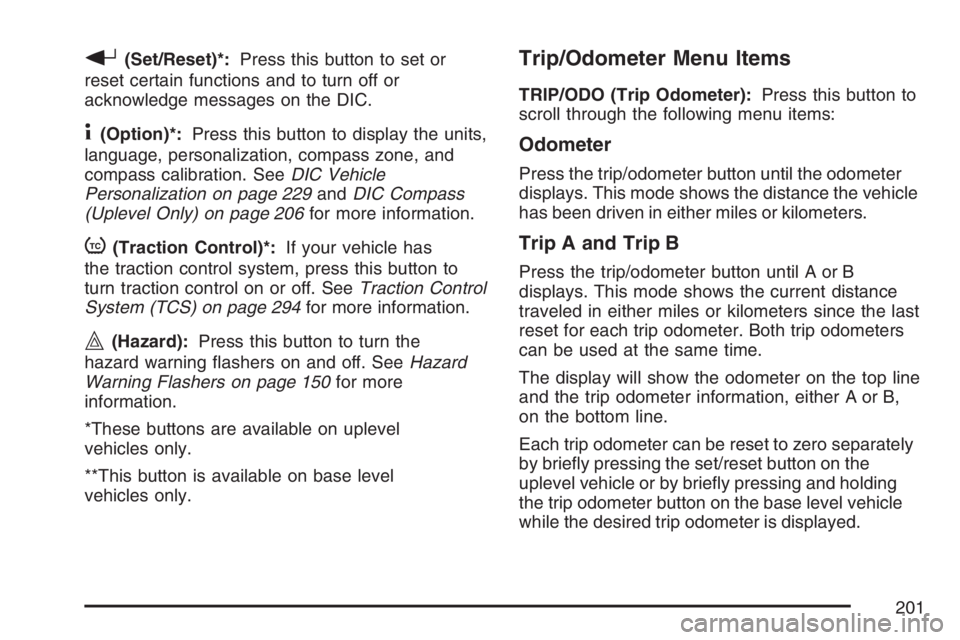
r(Set/Reset)*:Press this button to set or
reset certain functions and to turn off or
acknowledge messages on the DIC.
4(Option)*:Press this button to display the units,
language, personalization, compass zone, and
compass calibration. SeeDIC Vehicle
Personalization on page 229andDIC Compass
(Uplevel Only) on page 206for more information.
t(Traction Control)*:If your vehicle has
the traction control system, press this button to
turn traction control on or off. SeeTraction Control
System (TCS) on page 294for more information.
|(Hazard):Press this button to turn the
hazard warning �ashers on and off. SeeHazard
Warning Flashers on page 150for more
information.
*These buttons are available on uplevel
vehicles only.
**This button is available on base level
vehicles only.
Trip/Odometer Menu Items
TRIP/ODO (Trip Odometer):Press this button to
scroll through the following menu items:
Odometer
Press the trip/odometer button until the odometer
displays. This mode shows the distance the vehicle
has been driven in either miles or kilometers.
Trip A and Trip B
Press the trip/odometer button until A or B
displays. This mode shows the current distance
traveled in either miles or kilometers since the last
reset for each trip odometer. Both trip odometers
can be used at the same time.
The display will show the odometer on the top line
and the trip odometer information, either A or B,
on the bottom line.
Each trip odometer can be reset to zero separately
by brie�y pressing the set/reset button on the
uplevel vehicle or by brie�y pressing and holding
the trip odometer button on the base level vehicle
while the desired trip odometer is displayed.
201
Page 202 of 512
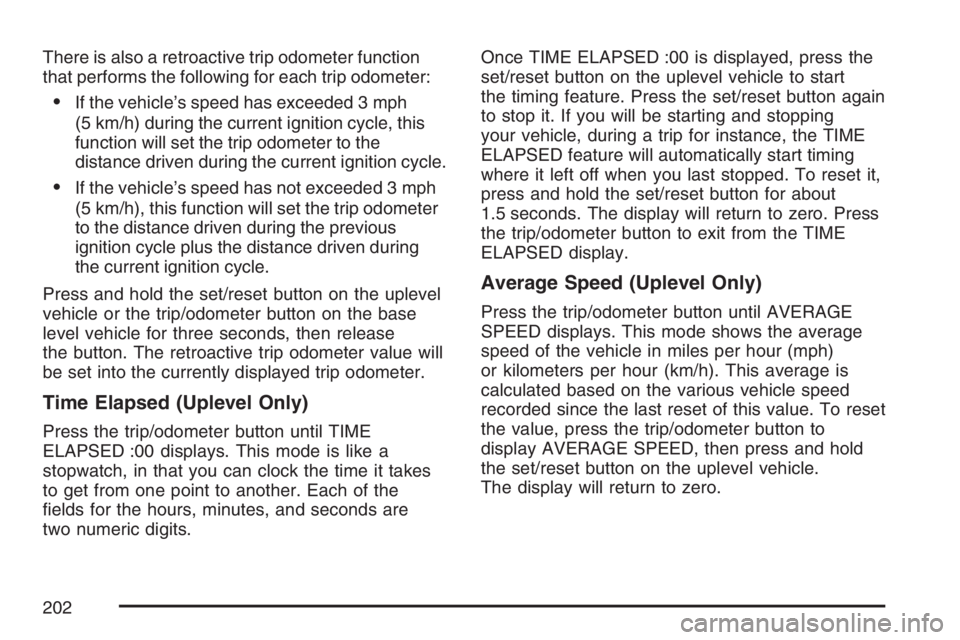
There is also a retroactive trip odometer function
that performs the following for each trip odometer:
If the vehicle’s speed has exceeded 3 mph
(5 km/h) during the current ignition cycle, this
function will set the trip odometer to the
distance driven during the current ignition cycle.
If the vehicle’s speed has not exceeded 3 mph
(5 km/h), this function will set the trip odometer
to the distance driven during the previous
ignition cycle plus the distance driven during
the current ignition cycle.
Press and hold the set/reset button on the uplevel
vehicle or the trip/odometer button on the base
level vehicle for three seconds, then release
the button. The retroactive trip odometer value will
be set into the currently displayed trip odometer.
Time Elapsed (Uplevel Only)
Press the trip/odometer button until TIME
ELAPSED :00 displays. This mode is like a
stopwatch, in that you can clock the time it takes
to get from one point to another. Each of the
�elds for the hours, minutes, and seconds are
two numeric digits.Once TIME ELAPSED :00 is displayed, press the
set/reset button on the uplevel vehicle to start
the timing feature. Press the set/reset button again
to stop it. If you will be starting and stopping
your vehicle, during a trip for instance, the TIME
ELAPSED feature will automatically start timing
where it left off when you last stopped. To reset it,
press and hold the set/reset button for about
1.5 seconds. The display will return to zero. Press
the trip/odometer button to exit from the TIME
ELAPSED display.
Average Speed (Uplevel Only)
Press the trip/odometer button until AVERAGE
SPEED displays. This mode shows the average
speed of the vehicle in miles per hour (mph)
or kilometers per hour (km/h). This average is
calculated based on the various vehicle speed
recorded since the last reset of this value. To reset
the value, press the trip/odometer button to
display AVERAGE SPEED, then press and hold
the set/reset button on the uplevel vehicle.
The display will return to zero.
202
Page 203 of 512
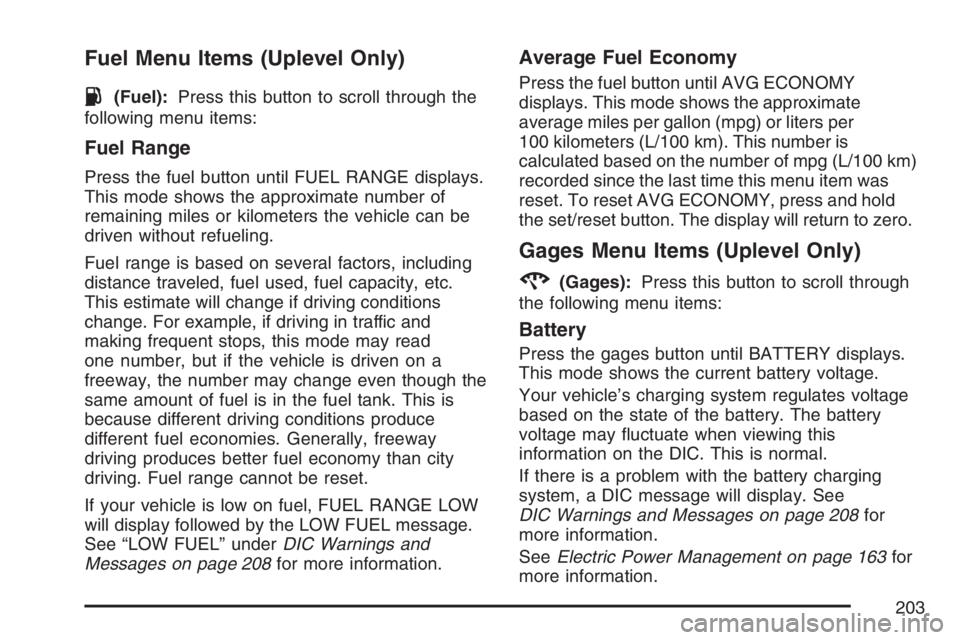
Fuel Menu Items (Uplevel Only)
.
(Fuel):Press this button to scroll through the
following menu items:
Fuel Range
Press the fuel button until FUEL RANGE displays.
This mode shows the approximate number of
remaining miles or kilometers the vehicle can be
driven without refueling.
Fuel range is based on several factors, including
distance traveled, fuel used, fuel capacity, etc.
This estimate will change if driving conditions
change. For example, if driving in traffic and
making frequent stops, this mode may read
one number, but if the vehicle is driven on a
freeway, the number may change even though the
same amount of fuel is in the fuel tank. This is
because different driving conditions produce
different fuel economies. Generally, freeway
driving produces better fuel economy than city
driving. Fuel range cannot be reset.
If your vehicle is low on fuel, FUEL RANGE LOW
will display followed by the LOW FUEL message.
See “LOW FUEL” underDIC Warnings and
Messages on page 208for more information.
Average Fuel Economy
Press the fuel button until AVG ECONOMY
displays. This mode shows the approximate
average miles per gallon (mpg) or liters per
100 kilometers (L/100 km). This number is
calculated based on the number of mpg (L/100 km)
recorded since the last time this menu item was
reset. To reset AVG ECONOMY, press and hold
the set/reset button. The display will return to zero.
Gages Menu Items (Uplevel Only)
2
(Gages):Press this button to scroll through
the following menu items:
Battery
Press the gages button until BATTERY displays.
This mode shows the current battery voltage.
Your vehicle’s charging system regulates voltage
based on the state of the battery. The battery
voltage may �uctuate when viewing this
information on the DIC. This is normal.
If there is a problem with the battery charging
system, a DIC message will display. See
DIC Warnings and Messages on page 208for
more information.
SeeElectric Power Management on page 163for
more information.
203
Page 204 of 512
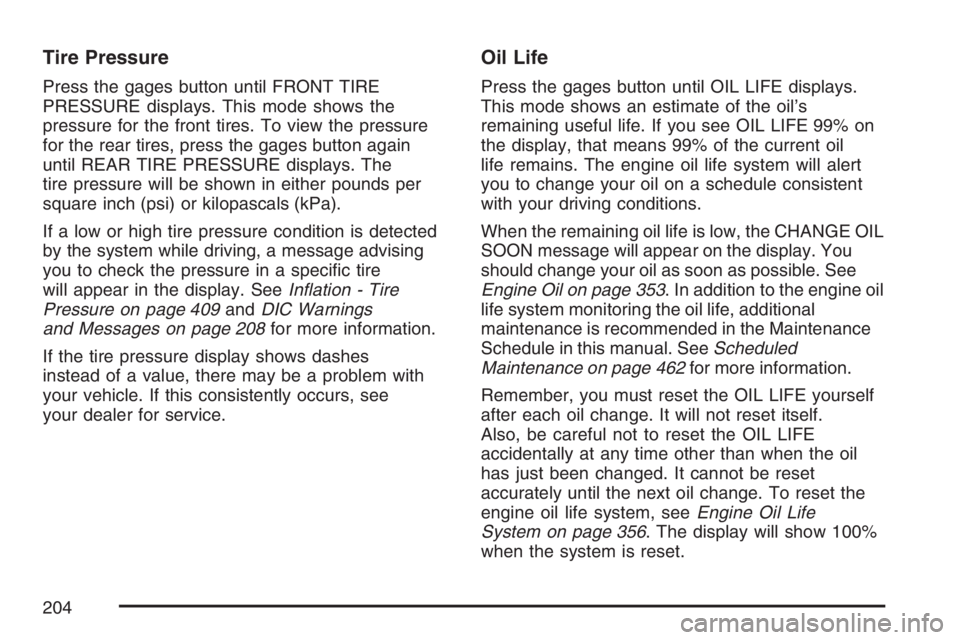
Tire Pressure
Press the gages button until FRONT TIRE
PRESSURE displays. This mode shows the
pressure for the front tires. To view the pressure
for the rear tires, press the gages button again
until REAR TIRE PRESSURE displays. The
tire pressure will be shown in either pounds per
square inch (psi) or kilopascals (kPa).
If a low or high tire pressure condition is detected
by the system while driving, a message advising
you to check the pressure in a speci�c tire
will appear in the display. SeeIn�ation - Tire
Pressure on page 409andDIC Warnings
and Messages on page 208for more information.
If the tire pressure display shows dashes
instead of a value, there may be a problem with
your vehicle. If this consistently occurs, see
your dealer for service.
Oil Life
Press the gages button until OIL LIFE displays.
This mode shows an estimate of the oil’s
remaining useful life. If you see OIL LIFE 99% on
the display, that means 99% of the current oil
life remains. The engine oil life system will alert
you to change your oil on a schedule consistent
with your driving conditions.
When the remaining oil life is low, the CHANGE OIL
SOON message will appear on the display. You
should change your oil as soon as possible. See
Engine Oil on page 353. In addition to the engine oil
life system monitoring the oil life, additional
maintenance is recommended in the Maintenance
Schedule in this manual. SeeScheduled
Maintenance on page 462for more information.
Remember, you must reset the OIL LIFE yourself
after each oil change. It will not reset itself.
Also, be careful not to reset the OIL LIFE
accidentally at any time other than when the oil
has just been changed. It cannot be reset
accurately until the next oil change. To reset the
engine oil life system, seeEngine Oil Life
System on page 356. The display will show 100%
when the system is reset.
204
Page 205 of 512
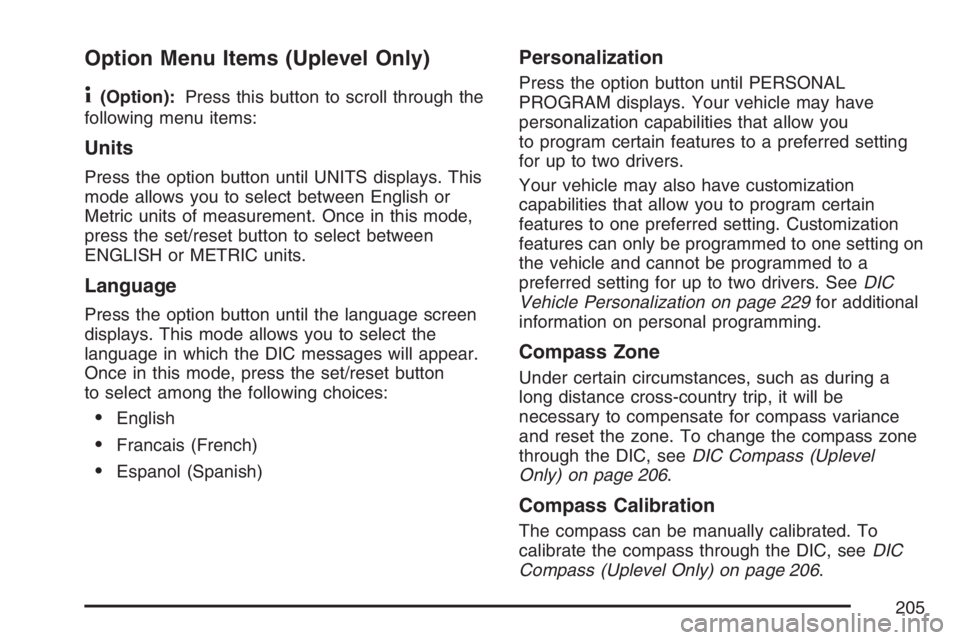
Option Menu Items (Uplevel Only)
4
(Option):Press this button to scroll through the
following menu items:
Units
Press the option button until UNITS displays. This
mode allows you to select between English or
Metric units of measurement. Once in this mode,
press the set/reset button to select between
ENGLISH or METRIC units.
Language
Press the option button until the language screen
displays. This mode allows you to select the
language in which the DIC messages will appear.
Once in this mode, press the set/reset button
to select among the following choices:
English
Francais (French)
Espanol (Spanish)
Personalization
Press the option button until PERSONAL
PROGRAM displays. Your vehicle may have
personalization capabilities that allow you
to program certain features to a preferred setting
for up to two drivers.
Your vehicle may also have customization
capabilities that allow you to program certain
features to one preferred setting. Customization
features can only be programmed to one setting on
the vehicle and cannot be programmed to a
preferred setting for up to two drivers. SeeDIC
Vehicle Personalization on page 229for additional
information on personal programming.
Compass Zone
Under certain circumstances, such as during a
long distance cross-country trip, it will be
necessary to compensate for compass variance
and reset the zone. To change the compass zone
through the DIC, seeDIC Compass (Uplevel
Only) on page 206.
Compass Calibration
The compass can be manually calibrated. To
calibrate the compass through the DIC, seeDIC
Compass (Uplevel Only) on page 206.
205
Page 206 of 512
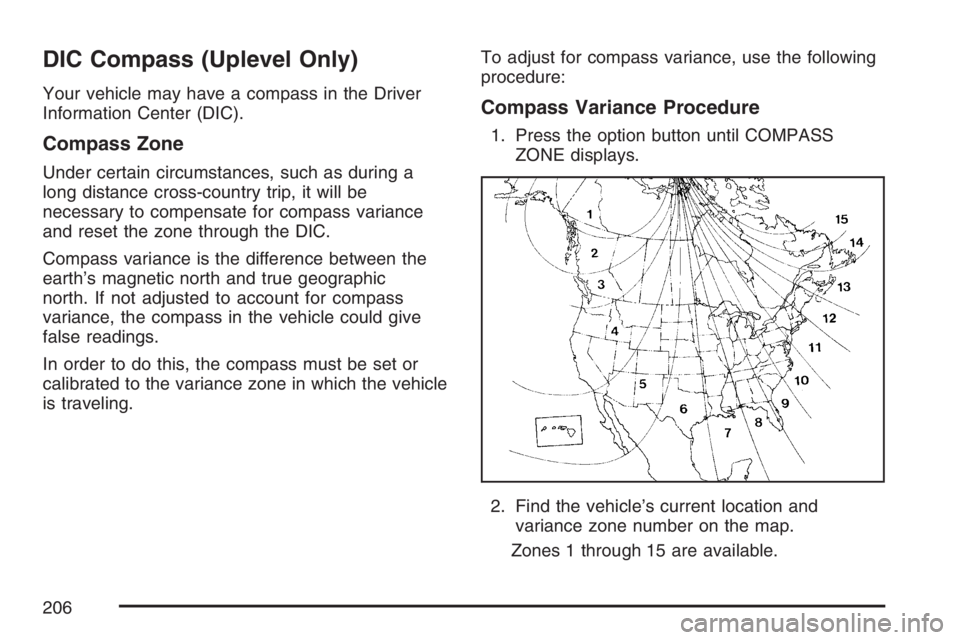
DIC Compass (Uplevel Only)
Your vehicle may have a compass in the Driver
Information Center (DIC).
Compass Zone
Under certain circumstances, such as during a
long distance cross-country trip, it will be
necessary to compensate for compass variance
and reset the zone through the DIC.
Compass variance is the difference between the
earth’s magnetic north and true geographic
north. If not adjusted to account for compass
variance, the compass in the vehicle could give
false readings.
In order to do this, the compass must be set or
calibrated to the variance zone in which the vehicle
is traveling.To adjust for compass variance, use the following
procedure:
Compass Variance Procedure
1. Press the option button until COMPASS
ZONE displays.
2. Find the vehicle’s current location and
variance zone number on the map.
Zones 1 through 15 are available.
206
Page 207 of 512
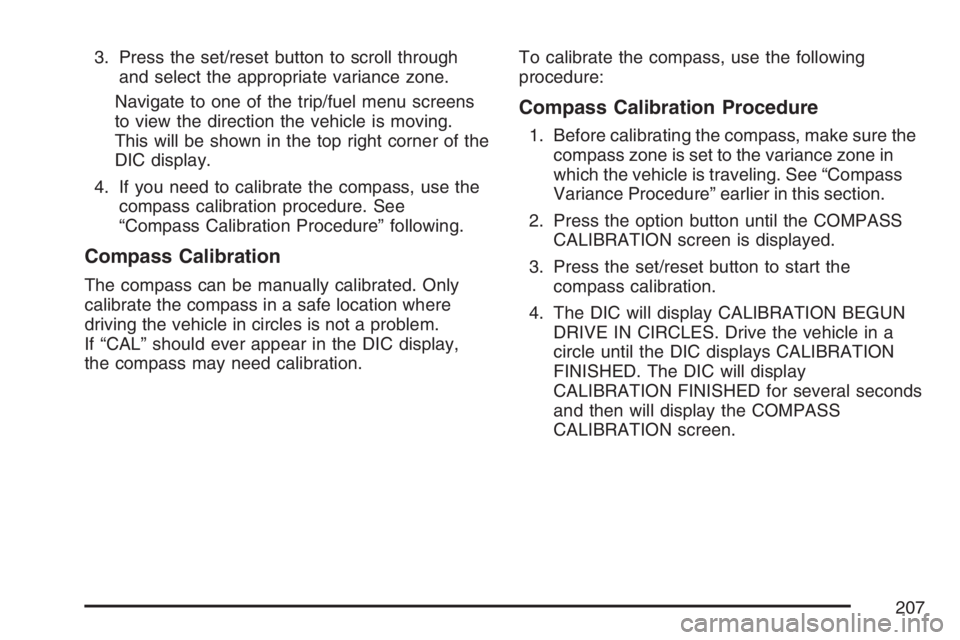
3. Press the set/reset button to scroll through
and select the appropriate variance zone.
Navigate to one of the trip/fuel menu screens
to view the direction the vehicle is moving.
This will be shown in the top right corner of the
DIC display.
4. If you need to calibrate the compass, use the
compass calibration procedure. See
“Compass Calibration Procedure” following.
Compass Calibration
The compass can be manually calibrated. Only
calibrate the compass in a safe location where
driving the vehicle in circles is not a problem.
If “CAL” should ever appear in the DIC display,
the compass may need calibration.To calibrate the compass, use the following
procedure:
Compass Calibration Procedure
1. Before calibrating the compass, make sure the
compass zone is set to the variance zone in
which the vehicle is traveling. See “Compass
Variance Procedure” earlier in this section.
2. Press the option button until the COMPASS
CALIBRATION screen is displayed.
3. Press the set/reset button to start the
compass calibration.
4. The DIC will display CALIBRATION BEGUN
DRIVE IN CIRCLES. Drive the vehicle in a
circle until the DIC displays CALIBRATION
FINISHED. The DIC will display
CALIBRATION FINISHED for several seconds
and then will display the COMPASS
CALIBRATION screen.
207
Page 208 of 512
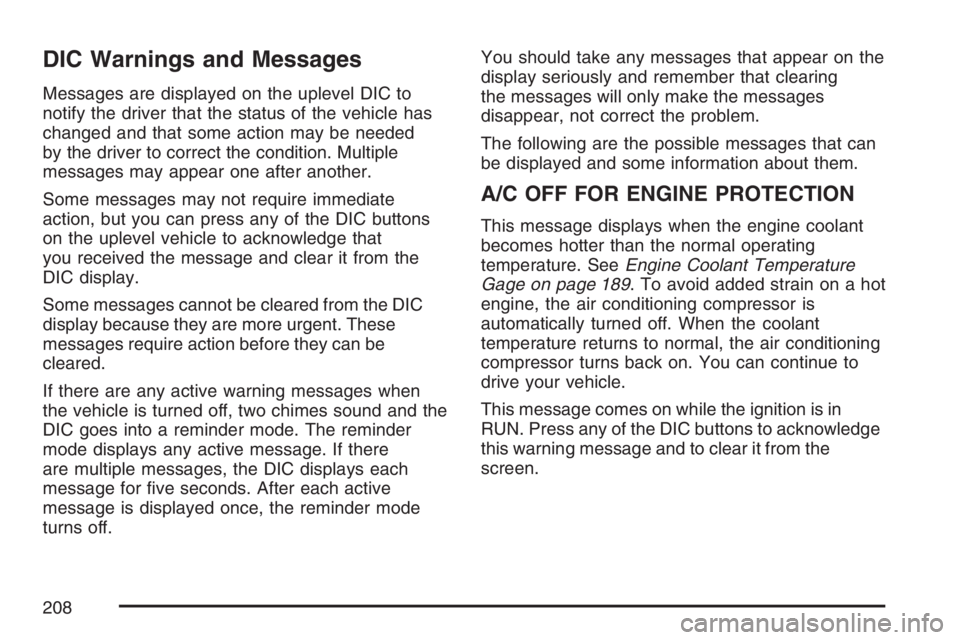
DIC Warnings and Messages
Messages are displayed on the uplevel DIC to
notify the driver that the status of the vehicle has
changed and that some action may be needed
by the driver to correct the condition. Multiple
messages may appear one after another.
Some messages may not require immediate
action, but you can press any of the DIC buttons
on the uplevel vehicle to acknowledge that
you received the message and clear it from the
DIC display.
Some messages cannot be cleared from the DIC
display because they are more urgent. These
messages require action before they can be
cleared.
If there are any active warning messages when
the vehicle is turned off, two chimes sound and the
DIC goes into a reminder mode. The reminder
mode displays any active message. If there
are multiple messages, the DIC displays each
message for �ve seconds. After each active
message is displayed once, the reminder mode
turns off.You should take any messages that appear on the
display seriously and remember that clearing
the messages will only make the messages
disappear, not correct the problem.
The following are the possible messages that can
be displayed and some information about them.
A/C OFF FOR ENGINE PROTECTION
This message displays when the engine coolant
becomes hotter than the normal operating
temperature. SeeEngine Coolant Temperature
Gage on page 189. To avoid added strain on a hot
engine, the air conditioning compressor is
automatically turned off. When the coolant
temperature returns to normal, the air conditioning
compressor turns back on. You can continue to
drive your vehicle.
This message comes on while the ignition is in
RUN. Press any of the DIC buttons to acknowledge
this warning message and to clear it from the
screen.
208
Page 209 of 512
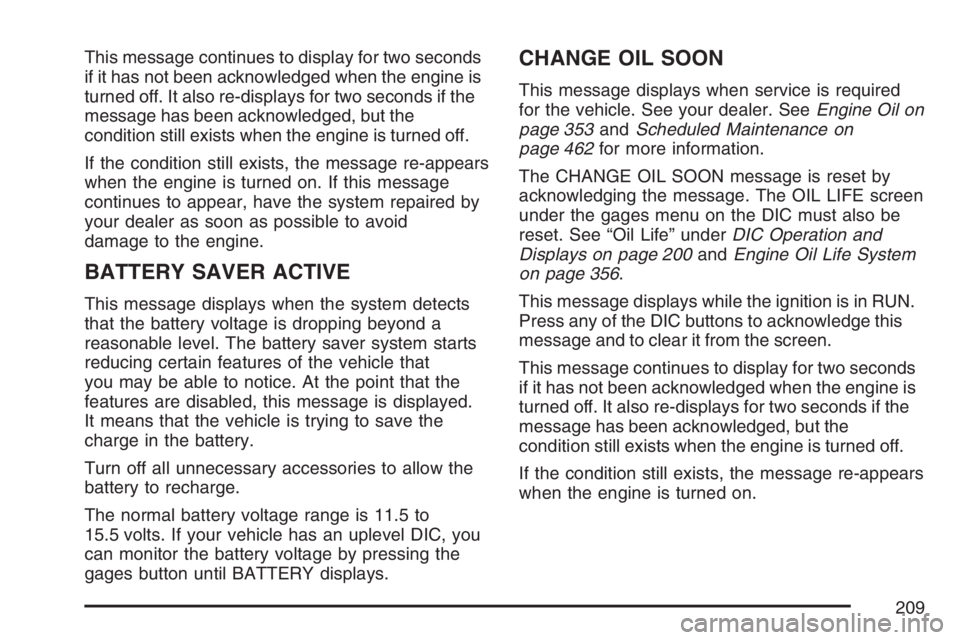
This message continues to display for two seconds
if it has not been acknowledged when the engine is
turned off. It also re-displays for two seconds if the
message has been acknowledged, but the
condition still exists when the engine is turned off.
If the condition still exists, the message re-appears
when the engine is turned on. If this message
continues to appear, have the system repaired by
your dealer as soon as possible to avoid
damage to the engine.
BATTERY SAVER ACTIVE
This message displays when the system detects
that the battery voltage is dropping beyond a
reasonable level. The battery saver system starts
reducing certain features of the vehicle that
you may be able to notice. At the point that the
features are disabled, this message is displayed.
It means that the vehicle is trying to save the
charge in the battery.
Turn off all unnecessary accessories to allow the
battery to recharge.
The normal battery voltage range is 11.5 to
15.5 volts. If your vehicle has an uplevel DIC, you
can monitor the battery voltage by pressing the
gages button until BATTERY displays.
CHANGE OIL SOON
This message displays when service is required
for the vehicle. See your dealer. SeeEngine Oil on
page 353andScheduled Maintenance on
page 462for more information.
The CHANGE OIL SOON message is reset by
acknowledging the message. The OIL LIFE screen
under the gages menu on the DIC must also be
reset. See “Oil Life” underDIC Operation and
Displays on page 200andEngine Oil Life System
on page 356.
This message displays while the ignition is in RUN.
Press any of the DIC buttons to acknowledge this
message and to clear it from the screen.
This message continues to display for two seconds
if it has not been acknowledged when the engine is
turned off. It also re-displays for two seconds if the
message has been acknowledged, but the
condition still exists when the engine is turned off.
If the condition still exists, the message re-appears
when the engine is turned on.
209
Page 210 of 512
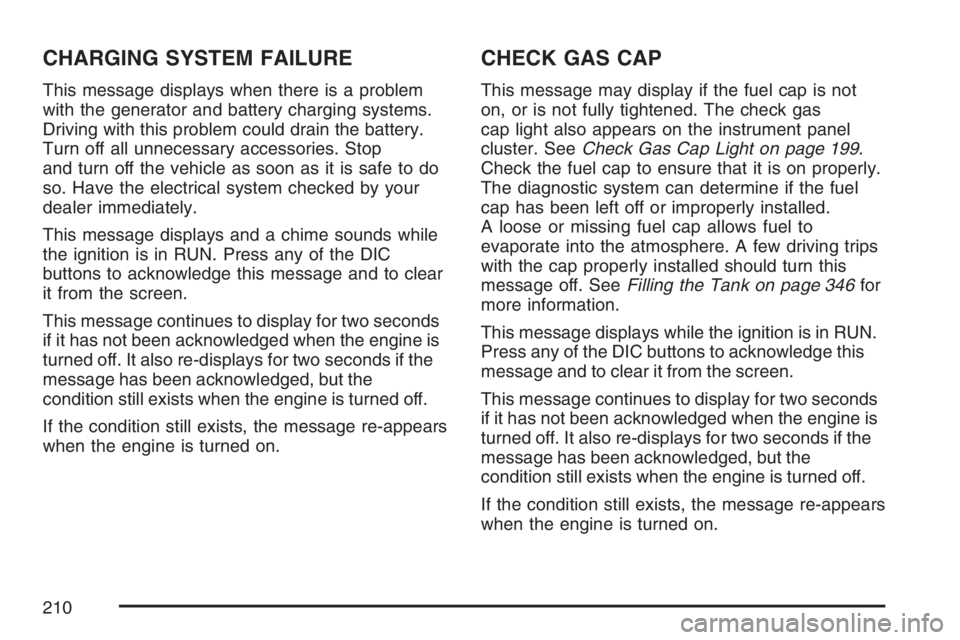
CHARGING SYSTEM FAILURE
This message displays when there is a problem
with the generator and battery charging systems.
Driving with this problem could drain the battery.
Turn off all unnecessary accessories. Stop
and turn off the vehicle as soon as it is safe to do
so. Have the electrical system checked by your
dealer immediately.
This message displays and a chime sounds while
the ignition is in RUN. Press any of the DIC
buttons to acknowledge this message and to clear
it from the screen.
This message continues to display for two seconds
if it has not been acknowledged when the engine is
turned off. It also re-displays for two seconds if the
message has been acknowledged, but the
condition still exists when the engine is turned off.
If the condition still exists, the message re-appears
when the engine is turned on.
CHECK GAS CAP
This message may display if the fuel cap is not
on, or is not fully tightened. The check gas
cap light also appears on the instrument panel
cluster. SeeCheck Gas Cap Light on page 199.
Check the fuel cap to ensure that it is on properly.
The diagnostic system can determine if the fuel
cap has been left off or improperly installed.
A loose or missing fuel cap allows fuel to
evaporate into the atmosphere. A few driving trips
with the cap properly installed should turn this
message off. SeeFilling the Tank on page 346for
more information.
This message displays while the ignition is in RUN.
Press any of the DIC buttons to acknowledge this
message and to clear it from the screen.
This message continues to display for two seconds
if it has not been acknowledged when the engine is
turned off. It also re-displays for two seconds if the
message has been acknowledged, but the
condition still exists when the engine is turned off.
If the condition still exists, the message re-appears
when the engine is turned on.
210